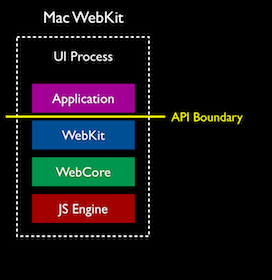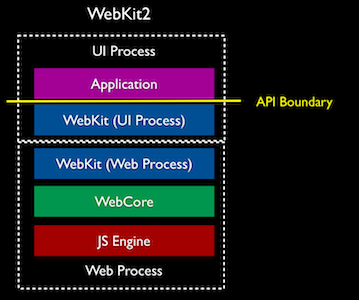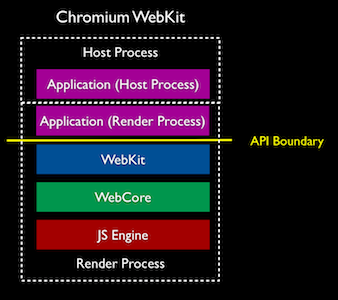Webkit, webkit2 and HTML5
WebKit (based on KHTML) is a layout engine designed to allow web browsers to render web pages. WebKit powers Google Chrome, Safari, the experimental browser included with the Amazon Kindle ebook reader...
WebKit is used as the rendering engine.
The WebKit engine provides a set of classes to display web content in windows (it also implements browser features such as following links when clicked by the user and managing a history of pages recently visited).
2003
Written in C++, it's fewer than 140,000 lines of code and is cleanly designed and standards compliant (@Jan 2003; see the email of the engineering manager of Safari: http://lists.kde.org/?l=kfm-devel&m=104197092318639&w=2).
2007
The project announced (@ nov 2007) that it had accomplished support for HTML5 media features, allowing for embedded video to be natively rendered and script-controlled in WebKit (http://www.webkit.org/blog/140/html5-media-support/).
The HTML5 video and audio elements add native support for embedding video and audio content in web pages. They also provide a rich scripting API for controlling playback. Adding video to a web page is almost as simple as adding an image. The current implementation supports all formats that QuickTime supports, including installed 3rd party codecs.
2008
Google released a very large portion of Chrome's source code, including its V8 JavaScript engine, as an open source project entitled Chromium. Chromium implements the same feature set as Chrome, but lacks built-in automatic updates and Google branding. Chromium, unlike the pre-release versions of Chrome, is updated almost every day. It does not include the built-in Flash Player and Google Auto-updater found in Chrome.
http://www.google.com/chrome
http://www.chromium.org/
2010
Differences between chromium webkit and webkit2.
WebKit2 is designed to support a split process model, where the web content (JavaScript, HTML, layout...) runs in a separate process from the application user interface. This model is similar to what Google Chrome offers, with the major difference being that it has built the process split model directly into the framework, allowing other clients to use it. Currently WebKit2 is available for Mac and Windows. Webkit2 is an incompatible API change from the original WebKit (so it will probably be installed as something like /System/Library/WebKit2.framework on Mac).
http://trac.webkit.org/wiki/WebKit2
How is This Different from Chromium WebKit?
Chromium takes a different approach to multiprocess:
Notice that in this case, the the process boundary is ABOVE the API boundary.
Chromium WebKit does not directly provide a multiprocess framework, rather, it is optimized for use as a component of a multiprocess application, which does all the proxying and process management itself. The Chrome team at Google did a great job at trailblazing multiprocess browsing with Chrome. But it's difficult to reuse their work, because the critical logic for process management, proxying between processes and sandboxing is all part of the Chrome application, rather than part of the API layer. So if another WebKit-based application or another port wanted to do multiprocess based on Chromium WebKit, it would be necessary to reinvent or cut & paste a great deal of code.
http://trac.webkit.org/wiki/Chromium
2011 "HTML5player" tactics
The Chrome Product manager announced (@Jan 2011) that Chrome will no longer support H.264 video codec for its HTML 5 player, citing the desire to bring Google Chrome more inline with the currently available open codecs available in the Chromium project (http://blog.chromium.org/2011/01/html-video-codec-support-in-chrome.html):
"We expect even more rapid innovation in the web media platform in the coming year and are focusing our investments in those technologies that are developed and licensed based on open web principles. To that end, we are changing Chrome’s HTML5 video support to make it consistent with the codecs already supported by the open Chromium project. Specifically, we are supporting the WebM (VP8) and Theora video codecs, and will consider adding support for other high-quality open codecs in the future. Though H.264 plays an important role in video, as our goal is to enable open innovation, support for the codec will be removed and our resources directed towards completely open codec technologies."
The WebM Project was launched (@2010) to bring an open, world-class video codec to the web: http://www.webmproject.org/
Select the categories WebP and WebM in this blog...
-----------------Now (@June 2011):
Chrome was the third most widely used browser.
See the slope of its increase (more than X2/year): http://gs.statcounter.com/
around 21% worldwide usage share of web browsers (20% Europe and 19% France), according to StatCounter (@ june 2011):
See the timeline representing the history of various web browsers:
http://en.wikipedia.org/wiki/List_of_web_browsers#WebKit-based
See the comparison of web browser engines:
http://en.wikipedia.org/wiki/Comparison_of_layout_engines
http://www.webkit.org/
Mobile:
Mobile web browsers have been built around WebKit such as the S60 browser on Symbian mobile phones, Blackberry Browser (ver 6.0+), and the Android Web browser.
WebKit will continue to dominate the mobile industry as the market penetration of smartphones:







Nice post. Great blog. Thanks for the share. Keep posting such kind of post on your blog.
ReplyDeletehtml5 converter